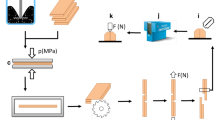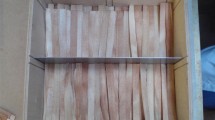Abstract
Effects of chemical treatment of wood on the bonding strength of Norway spruce strands (Picea abies Karst.) embedded in a cement matrix were investigated by means of a pull-out test. Strands of varying thickness were used whereas a strong influence of thickness on bonding strength could be observed. Using thick strands (800 μm) showed negative effect on bonding strength which is due to the swelling effect. The treatment of thin strands (400 μm) showed that using wet strands (∼ 90% moisture content) leads to the best results compared to untreated dry (12%) strands. By addition of setting accelerators (ammonium chloride) bonding strength of wet strands was even improved. Furthermore, effects of hot water and sodium hydroxide extraction as well as sodium silicate treatment were examined.
Zusammenfassung
Zur Bestimmung der Bindefestigkeit zwischen Holz und Zement wurden anhand von unterschiedlich behandelten Strands aus Fichtenholz (Picea abies Karst.) Auszugstests durchgeführt. Strands mit unterschiedlicher Dicke wurden in die Zementmatrix eingebettet, wobei ein starker Einfluss der Stranddicke auf die Bindefestigkeit nachgewiesen werden konnte. Die Verwendung dicker Strands (800 μm) zeigte einen negativen Einfluss auf die Bindefestigkeit, welcher auf Quellungseffekte zurückzuführen ist. Die Behandlung dünner Strands (400 μm) ergab, dass die Verwendung feuchter Strands (u ∼ 90%) zu den besten Ergebnissen führte. Bei einer zusätzlichen Verwendung eines Erstarrungsbeschleunigers (Ammoniumchlorid) konnte die Bindefestigkeit weiter verbessert werden. Ferner wurden die Effekte von Heißwasser- und Natronlaugeextraktion sowie die Behandlung mit Natronwasserglas untersucht.




Similar content being viewed by others
References
Alberto MM, Mougel E, Zoulalian A (2000) Compatibility of some tropical hardwood species with Portland cement using isothermal calorimetry. Forest Prod J 50:83–88
Badejo SOJ (1988) Effect of flake geometry on properties of cement-bonded particleboard from mixed tropical hardwoods. Wood Sci Technol 22:357–370
Banholzer B, Brameshuber W, Geus J, Jung W (2004) Bestimmung eines Verbundgesetzes auf Basis von Einzelfaser-Pull-Out-Versuchen. Bautechnik 81(10):806–812
Bietz H, Uschmann W (1984) Zum Verfestigungsverhalten von Holz-Zement-Verbunden beim Einsatz von Holzresten. Holztechnologie 25(3):116–118
Brandstetr J, Polcer J, Krátký J, Holesinsky R, Havlica J (2001) Possibilities of the use of isoperibolic calorimetry for assessing the hydration behaviour of cementitious systems. Cement Concrete Res 31:941–947
Coatanlem P, Jauberthie R, Rendell F (2006) Lightweight wood chipping concrete durability. Constr. Build. Mater. 20:776–781
Cziesielski E (1975) Beton mit Fasern aus Holz. Holz Roh- Werkst 33:303–307
Dewitz K, Kuschy B, Otto T (1984) Stofftransporte bei der Abbindung zementgebundener Holzwerkstoffe. Holztechnologie 3:151–154
Eusebio DA (2003) Cement bonded board: Today's Alternative. Technical forum in celebration of the 21st PCIERD Anniversary, Dept. of Science and Tech, held at Edsa Shangri-La, EDSA, Pasig City, 23–45
Eusebio DA, Soriano FP, Cabangon RJ, Evans PD (2000) Manufacture of low-cost wood-cement composites in the Philippines using plantation-grown Australian species: I. Eucalyptus. Wood-Cement Composites in the Asia-Pacific Region, Canberra, Australia, 105–114
Evans AG, Zok FW, Davis J (1991) The role of interfaces in fiber-reinforced brittle matrix composites. Composite Science and Technology 42:3–24
Frybort S, Mauritz R, Teischinger A, Müller U (2008) Cement bonded composites – A mechanical review. Bioresources 3:602–626
Geimer RL, Souza MR, Moslemi AA (1996) Low-density cement-bonded wood composites made conventionally and with carbon dioxide injection. Drvna Industrija 47(2):55–62
Govin A, Peschard A, Fredon E, Guyonnet R (2005) New insights into wood and cement interaction. Holzforschung 59:330–335
Hermawan D, Hata T, Kawai S, Nagadomi W, Kuroki Y (2002) Manufacturing oil palm fronds cement-bonded board cured by gaseous or supercritical carbon dioxide. J Wood Sci 48:20–24
Hermawan D, Hata T, Umuemura K, Kawai S, Nagadomi W, Kuroki Y (2001) Rapid production of high-strength cement-bonded particleboard using gaseous or supercritical carbon dioxide. J Wood Sci 47:294–300
Hon DNS, Shiraishi N (2001) Wood and Cellulosic Chemistry. Marcel Dekker, Inc., New York, Basel
Issa MA, Shafiq AB, Hammad AM (1996) Crack arrest in mortar matrix reinforced with unidirectionally aligned fibers. Cement and Concrete Research 26(8):1245–1256
Jorge FC, Pereira C, Ferreira JMF (2004) Wood-cement composites: a review. Holz Roh- Werkst 62:370–377
Karade SR, Irle M, Maher K (2003) Assessment of wood-cement compatibility: A new approach. Holzforschung 57:672–680
Kavvouras PK (1987) Suitability of Quercus conferta wood for the manufacture of cement-bonded flakeboards. Holzforschung 41:159–163
Lange DA, Ouyang C, Shah SP (1996) Behavior of cement based matrices reinforced by randomly dispersed microfibers. Advanced Cement Based Materials 3(1):20–30
Lawrence P (1972) Some theoretical considerations of fibre pull-out from an elastic matrix. J Mater Sci 7:1–6
Laws V (1982) Micromechanical aspects of the fibre-cement bond. Composites 113:145–151
Lee AWC, Hong Z (1986) Compressive strength of cylindrical samples as an indicator of wood-cement compatibility. Forest Prod J 36:87–90
Moslemi AA, Garcia JF, Hofstrand AD (1983) Effect of various treatments and additives on wood-Portland cement-water systems. Wood Fibre Sci 15:164–176
Pehanich JL, Blankenhorn PR, Silsbee MR (2004) Wood fiber surface treatment level effects on selected mechanical properties of wood fiber-cement composites. Cement Concrete Res 34:59–65
Pereira C, Jorge FC, Ferreira JMF (2005) Adsorption of Cations from a Cement Suspension onto Lignocellulosic Substrates and its Influence on Cement Setting. J Wood Chem Technol 25:231–244
Pereira C, Jorge FC, Irle MA, Ferreira JM (2003) Extractive contents of two woods and cork of Portuguese origin and the interaction of these substrates with cement suspensions. Forest Prod J 53:34–43
Prince W, Espagne M, Aitcin PC (2003) Ettringite formation: A crucial step in cement superplasticizer compatibility. Cement Concrete Res 33:635–641
Schubert B, Wienhaus O, Bloßfeld O (1990a) Untersuchungen zum System Holz-Zement. Einfluss unterschiedlicher Holzarten auf das Abbindeverhalten von Holz-Zement-Mischungen und Möglichkeiten zur Modifizierung des Systems. Holz Roh- Werkst 48(11):423–428
Schubert B, Wienhaus O, Bloßfeld O (1990b) Untersuchungen zum System Holz-Zement. Einfluß unterschiedlicher Zementarten auf das Abbindeverhalten von Holz-Zement-Mischungen. Holz Roh- Werkst 48(5):185–189
Simatupang MH, Seddig N, Habighorst C, Geimer R (1990) Technologies for rapid production of mineral-bonded wood composite boards. Proceedings of the 2nd International Inorganic Bonded Wood and Fiber Composite Materials Conference, Madison, Wisconsin, USA, Forest Products Research Society
Tamba S, Jauberthie R, Lanos C, Rendell F (2001) Lightweight wood fibre concrete. Concr Sci Eng 3:53–57
Wei YM, Fujii T, Hiramatsu Y, Miyatake A, Yoshinaga S, Fujii T, Tomita B (2004) A preliminary investigation on microstructural characteristics of interfacial zone between cement and exploded wood fiber strand by using SEM-EDS. J Wood Sci 50:327–336
Wei YM, Tomita B, Hiramatsu Y, Miyatake A, Fujii T, Fujii T, Yoshinaga S (2003) Hydration behavior and compressive strength of cement mixed with exploded wood fiber strand obtained by the water-vapor explosion process. J Wood Sci 49:317–326
Wei YM, Tomita B, Hiramatsu Y, Miyatake A, Fujii T (2002) Study of hydration behaviors of wood-cement mixtures: compatibility of cement mixed with wood fiber strand obtained by the water-vapor explosion process. J Wood Sci 48:365–373
Wei YM, Zhou YG, Tomita B (2000a) Hydration behavior of wood cement-based composite I: evaluation of wood species effects on compatibility and strength with ordinary Portland cement. J Wood Sci 46:296–302
Wei YM, Zhou YG, Tomia B (2000b) Study of hydration behavior of wood cement-based composite. II: effect of chemical additives on the hydration characteristics and strengths of wood-cement composites. J Wood Sci 46:444–451
Wienhaus O (1979) Werkstoffe aus Holz und Zement. Holztechnologie 20(4):207–215
Wolfe RW, Gjinolli A (1996) Cement-Bonded Wood Composites as an Engineering Material. The Use of Recycled Wood and Paper in Building Applications. Forest Products Society, Madison, Wisconsin
Youngquist JA (1999) Wood-based composites and panel products. Wood handbook: wood as an engineering material. U.S. Dept. of Agriculture, Forest Service, Forest Products Laboratory, Madison, Wisconsin, USA
Yue YL, Li GZ, Xu XS, Zhao ZJ (2000) Properties and microstructures of plant-fiber-reinforced cement-based composites. Cement Concrete Res 30:1983–1986
Author information
Authors and Affiliations
Corresponding author
Rights and permissions
About this article
Cite this article
Frybort, S., Mauritz, R., Teischinger, A. et al. Determination of the bond strength of treated wood strands embedded in a cement matrix by means of a pull-out test. Eur. J. Wood Prod. 68, 407–414 (2010). https://doi.org/10.1007/s00107-009-0383-4
Received:
Published:
Issue Date:
DOI: https://doi.org/10.1007/s00107-009-0383-4




